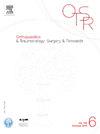Retroarticular drilling for osteochondritis dissecans of the talus: A systematic review
IF 2.3
3区 医学
Q2 ORTHOPEDICS
引用次数: 0
Abstract
Background
Opinions differ on the optimal treatment for stable talar osteochondritis dissecans (OCD) with intact cartilage. Some recommend conservative management, while others prefer surgical care, which includes debridement and micro-fractures, transarticular drilling through a direct or medial malleolus approach and retroarticular drilling. The rationale behind retroarticular drilling is to induce bone marrow healing without touching the intact cartilage. The goal of this systematic review is to summarize the clinical outcomes of retroarticular drilling as a standalone procedure for stable talar OCD with intact cartilage.
Patients and methods
A systematic review of the literature prospectively registered in the PROSPERO register was performed along the Preferred Reporting Items for Systematic Reviews and Meta-Analyses (PRISMA) guidelines. Medline, EMBASE and Evidence-Based Medicine databases were searched from inception to December 2021 for retroarticular drilling for stable talar OCD with an intact cartilage. Two independent evaluators screened the search results, selected the articles to be included in the analysis and assessed the methodological quality of all included articles with the Newcastle-Ottawa Scale (NOS).
Results
Twelve studies, on 99 patients were included in the final analysis. Methodological quality was poor for all the included studies. High heterogeneity prevented any pooling or meta-analysis, but favorable clinical results were reported according to excellent post-intervention scores on the American Orthopedic Foot and Anke Score (AOFAS), ranging from 88.9 to 100. There was also significant improvement in pain as measured by the Visual Analog Scale (VAS), ranging between 2.3 and 5.9.
Discussion
Favorable results seem to be achieved with retroarticular drilling without grafting for stable talar OCD with intact cartilage, but more powered comparative studies between surgical options and conservative management are needed to establish the gold standard treatment.
Level of evidence
IV.
后关节钻孔治疗距骨软骨炎:系统性综述。
背景:对于软骨完整的稳定型距骨软骨炎(OCD)的最佳治疗方法众说纷纭。一些人建议保守治疗,而另一些人则倾向于手术治疗,包括清创和微骨折、通过直接或内侧踝骨途径进行经关节钻孔以及后关节钻孔。后关节钻孔的原理是在不接触完整软骨的情况下诱导骨髓愈合。本系统性综述的目的是总结后关节钻孔作为一种独立手术治疗稳定的距骨OCD且软骨完好的临床结果:根据系统综述和荟萃分析首选报告项目(PRISMA)指南,对在PROSPERO注册中心登记的前瞻性文献进行了系统综述。在 Medline、EMBASE 和循证医学数据库中检索了从开始到 2021 年 12 月期间有关后关节钻孔治疗稳定的距骨 OCD 且软骨完好的文献。两名独立评估员对检索结果进行了筛选,选出了纳入分析的文章,并采用纽卡斯尔-渥太华量表(NOS)对所有纳入文章的方法学质量进行了评估:最终分析共纳入了 12 项研究,涉及 99 名患者。所有纳入研究的方法学质量均较差。由于异质性较高,因此无法进行汇总或荟萃分析,但根据美国骨科足踝评分(AOFAS)显示,干预后的评分从 88.9 分到 100 分不等,临床效果良好。用视觉模拟量表(VAS)测量,疼痛也有明显改善,从 2.3 到 5.9 不等:讨论:对于软骨完好的稳定型距骨OCD,后关节钻孔而不植骨似乎能取得良好的效果,但需要对手术方案和保守治疗进行更多的研究,以确定金标准治疗方法:证据等级:IV。
本文章由计算机程序翻译,如有差异,请以英文原文为准。
求助全文
约1分钟内获得全文
求助全文
来源期刊
CiteScore
5.10
自引率
26.10%
发文量
329
审稿时长
12.5 weeks
期刊介绍:
Orthopaedics & Traumatology: Surgery & Research (OTSR) publishes original scientific work in English related to all domains of orthopaedics. Original articles, Reviews, Technical notes and Concise follow-up of a former OTSR study are published in English in electronic form only and indexed in the main international databases.

 求助内容:
求助内容: 应助结果提醒方式:
应助结果提醒方式:


